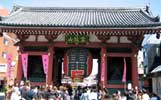Travel guide
Asakusa

Today Asakusa is festive and quaint. The crowds are drawn by Sensoji Temple, the Five Storied Pagoda and the traditional Nakamise shopping arcade. But for visitors between the sixteen and eighteen hundreds, the attraction was somewhat different - Asakusa contained the notorious "Yoshiwara", the city's licensed pleasure quarter.
Sensoji Temple has three gates. Kaminarimon Gate is the main one and you'll find it by following the signs from exit one of Asakusa Subway Station. The original was destroyed in the air raids of 1945, so this is a reconstruction built in 1960. On the right, notice the God of the Wind, and on the left, the God of Thunder. Just opposite the gate is Asakusa Tourist Information Centre. With plenty of free English maps to give away, it's open 10:00am to 5:00pm daily. Once through the gate you'll be in Nakamise Shopping Arcade. The street is lined with colourful, lively stalls selling traditional knick- knacks, festival foods and rice crackers. Hanzomon Gate marks the end of the street. Reconstructed in 1964, the treasures of Sensoji are stored inside.
The Five Storied Pagoda was built in 1973 and amongst others, it stands in honour of comedians! It's 53.32 meters high, reinforced with concrete and steel, and like all pagodas, running down the centre is a giant pillar of Japanese Cypress tree wood. Around this, the five stories are loosely packed, resulting in a highly flexible structure able to withstand earth tremours.
To the left of the temple, you'll see Hanayashiki Amusement Park. This, and the streets that surround, was once the site of the Yoshiwara, the licensed pleasure quarter of the city of Edo. Many a kabuki play and other works of art were inspired by life in the Yoshiwara. But conditions were appalling - arson was often the women's only revenge. Finally in 1923, the whole area was completely destroyed by fire - ironically though, a non-deliberate fire caused by the earthquake.
In the 1930's the area came alive again. But as foreign films were the latest big attraction it was cinemas that moved in and the area thrived. For each film, live translations and sound effects were provided by a "benshi". One benshi would use a number of different voices to act out all the parts. Some would also add in the odd little impromptu joke or two, and many would even do things like burn incense during funeral scenes!
Twenty years later however television came and the benshi were gone. Cinemas closed; pachinko parlours, game centres and strip clubs moved in. As a result, in terms of entertainment, many say Asakusa has died. Big business never took a hold either. Walk around a side street today.
- >> Back to travel guide
